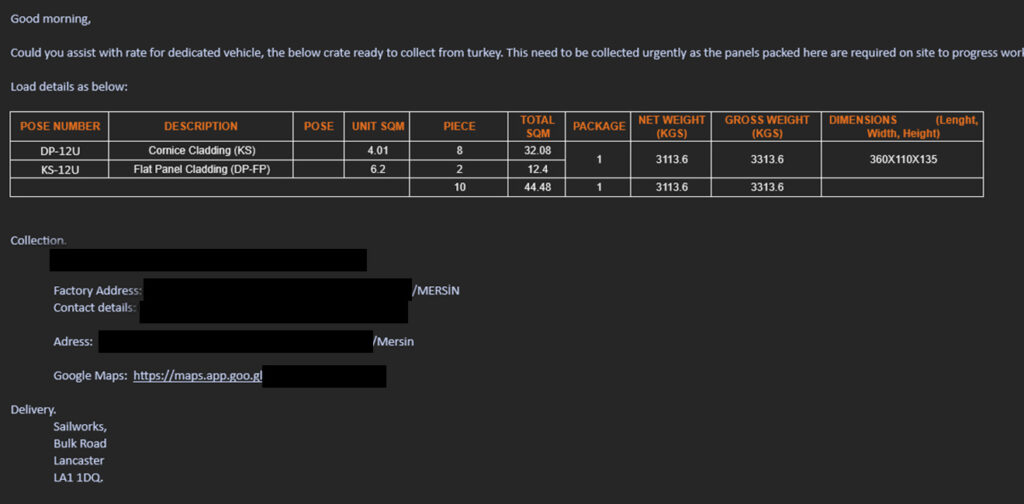How to Write a Freight Rate Inquiry and Get a Lower Transport Price – A Practical Guide
Konrad Spuła
Published 09.10.2025
3 min reading time

A well-written freight rate request can be one of the most effective ways to reduce your transport costs. When a freight forwarder has a clear understanding of your needs, they can respond faster, prepare a more accurate quote, and select the most suitable vehicle type for your shipment.
What to Include in the Email Subject Line?

Include the loading and unloading locations in the subject line, e.g. “Transport Munich – Bristol.”
This allows the transport company to quickly forward your inquiry to a specialist handling that particular route.
2. What to Include in the Email Body?
Provide the key shipment details, such as:
- Collection and delivery points, e.g. DE Munich 80331 – GB Bristol BS1 1DL
- Loading date, e.g. 5 October 2026
- Unloading date – either specific (e.g. 8 October 2025) or descriptive, such as “express,” “within a week,” or “no later than…”
- Shipment weight, e.g. 2,900 kg
- Number of pallets and dimensions, e.g. 4 euro pallets, 360 × 110 × 350 cm
- Type of transport – dedicated vehicle or part load
lub
- Vehicle type (optional), e.g. Standard curtain-sided solo truck
If you cannot provide all the details — for example, if you are unsure about the exact weight or the number of pallets — mention it in the email or give an approximate value.
If you’re arranging transport for the first time or only occasionally and find some terms confusing, don’t worry — this guide will help you understand what information you need to provide to get the best possible offer.
3. Additional (Optional) Information
Providing additional details can speed up the quotation process and may also affect the freight rate. These include:
- Cargo value (important for high-value transport, e.g. electronics, which may require additional security)
- Type of cargo (what kind of goods are being shipped?)
- Whether the cargo is hazardous (ADR)
- Whether customs clearance is required
- If using a refrigerated truck – specify the required temperature range
- Any special cargo securing requirements
4. What Not to Do?

There’s no need to attach technical documentation or provide lengthy company descriptions.
A freight forwarder only needs specific data to calculate the transport cost.
The more concise and structured your inquiry, the higher the chance you’ll receive several competitive offers quickly and be able to choose the most cost-effective option.
Example of a Well-Structured Freight Rate Inquiryotrzebnych informacji
Good Morning,
Please can I have a rate for the below.
This needs to be collected urgently as the goods are needed ASAP.
2 × 360 × 110 × 135 @ 250 kg
1 × 200 × 100 × 250 @ 1,200 kg
Collection from Turkey 33100 Akdeniz/Mersin – deadline max. 5 days
Delivery to Lancaster LA1 1DQ, UK
Regards,
Rick Porter
Customer Service Manager
Example of a Poorly Structured Inquiry – Too much information, disorganized data, lack of clarity.

Why a Clearer Inquiry Often Results in a Lower Freight Rate?
Speed – A freight forwarder receives hundreds of emails daily, many of which are rate requests. Their goal is to respond quickly and secure the most cost-effective transport option for each client.
If an email contains unnecessary details, lacks structure, or omits key information, there’s a high chance the forwarder will prioritize other, clearer requests first.
Competitive Pricing – It’s common for clients to send incomplete details — for instance, providing loading and delivery points, cargo weight, and loading time, but forgetting to specify whether they need dedicated transport or if groupage (partial load) is acceptable. Groupage shipments are usually cheaper, though slightly slower.
A precisely written inquiry also helps the forwarder choose the right vehicle. Often, instead of sending a large, more expensive truck, a smaller van or light truck may be sufficient — which significantly reduces the cost.



